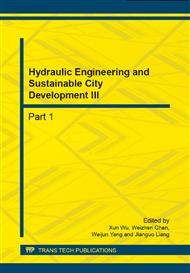[1]
Kim S. Life cycle assessment of embodied energy for building materials focused on high-rise apartments. Proceeding of the World Renewable Energy Congress(WREC), Florence, 1998: 155-1562.
Google Scholar
[2]
Cousins F, McGregor A. Specifying a green building. Green building challenge'98 international conference on the Performance assessment of buildings. Canada. Vancouver,1998: 26-28.
Google Scholar
[3]
China Building Materials Academy. Green building materials. Beijing: Chemical Industry Press, (2003).
Google Scholar
[4]
Liu Nianxiong, Wang Jing, Li Rong. China's urban residential carbon emissions calculation method. Journal of tsinghua university (natural science edition), 2009, 49(9): 1433-1436.
Google Scholar
[5]
Li Qiming, Ou Xiaoxing. The concept of low carbon architectural and its development. Building Economy, 2010(2): 41-43.
Google Scholar
[6]
Leif Gustavsson, Anna Joelsson, Roger Sathre. Life cycle primary energy use and carbon emission of an eight-storey wood-framed apartment building. Energy and Buildings, 2010, 42(2): 230-242.
DOI: 10.1016/j.enbuild.2009.08.018
Google Scholar
[7]
Gerilla GP, Teknomo K, Hokao K. An environmental assessment of wood and steel reinforced concrete housing construction. Building and Environment, 2007, 42(7): 2778-2784.
DOI: 10.1016/j.buildenv.2006.07.021
Google Scholar
[8]
Bribian, Uson, Scarpellini. Life cycle assessment in buildings: State-of -the-art and simplified LCA methodology as a complement for building certification. Building and Environment, 2009, 44(12): 2510-2520.
DOI: 10.1016/j.buildenv.2009.05.001
Google Scholar
[9]
He Fuchun, Fu Xiangzhao. Thinking and Suggestions about building carbon emissions quantification. Resources Economization & Environment Protection, 2010(6): 20-22.
Google Scholar
[10]
Zhang Zhihui, Shang Chunjing, Qian Kun. Carbon emission evaluation in building life cycle. Building Economy, 2010(2): 44-46.
Google Scholar
[11]
Neil May. Low carbon buildings and the problem of human behavior. Natural Building Technologies, 2004, (6): 65-78.
Google Scholar
[12]
Halpin D W. CYCLONE-Method for modeling job site processes. Journal of Construction Division, ASCE, 1977, 103(3): 489-499.
DOI: 10.1061/jcceaz.0000712
Google Scholar
[13]
Shuai Xiaogen. Quantitative study on the implicit environmental impacts assessment of construction projects. [D]. WuHan:Huazhong University of Science and Technology, (2009).
Google Scholar


